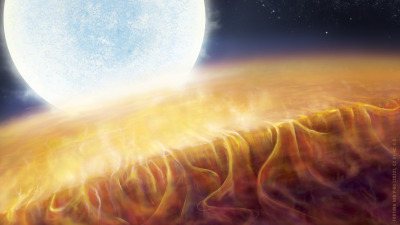A new approach to reveal the climate of KELT-9b
The exoplanet KELT-9b is predicted to have a permanent, scorching-hot
day-side and a permanent cooler night-side due to tidal locking.
A new study thanks to HARPS-N data at Telescopio Nazionale Galileo (TNG)
and led by Lorenzo Pino (INAF Astrophysical Observatory of Arcetri) in the
framework of the GAPS collaboration, allowed to verify this prediction.
The study also allowed to observe the effect that the different temperature
across the two hemispheres could have on the three-dimensional atmospheric
structure and climate of the planet.
In order to achieve this goal, the team used an innovative technique
specifically designed to exploit the HARPS-N data. They combined ideas
from Doppler-tomography, already employed to reconstruct the surface of
stars, together with phase curves, used to study the energy redistribution
in exoplanets.
The idea is that during one night of continuous observation of the system,
the planet shows different parts of its photosphere. With a period shorter
than one day on Earth, in one single night it moves by a quarter of its
orbit. With a combination of 5 nights of observations, (3 with HARPS-N at
TNG and 2 with CARMENES at CAHA), the researchers were able to cover half
of the orbit. In the absence of any atmospheric wind, they expected a
perfectly symmetric signal around the point of the atmosphere of KELT-9b
closest to the star surface. Previous works revealed that in most hot
planets there are deviations from this behavior: in particular a powerful
planet-scale winds can be generated due to the strong temperature contrast
between day-and night-side. Such winds blow at speeds of several
kilometers-per-second, preferentially in direction west to east.
Through convection, they can move towards the east the heat trapped in the
atmospheric gas directly facing the star. In this case, the symmetry is
broken, and we observe that the hottest spot in the atmosphere is shifted.
In the case of KELT-9b, the observations confirmed that no such shift is
likely present in its atmosphere, a result that is at first sight puzzling.
A possible answer is that in the hottest planets (T > 2000 K) the elements
found in the atmosphere start to ionize. Ions are charged atoms and they
can thus interact with the magnetic field of the planet. In this scenario,
the waves responsible of generating the east-ward wind are broken, and
atmospheric circulation transitions to a different geometry: winds would
blow directly from the day-side to the night-side. In this case, the
substellar atmospheric gas would still be moved towards the night-side,
heating it, but symmetry would be preserved and no shift in the hottest
spot of the atmosphere would be observed.
"This was never directly observed before, and we devised a possible way to
achieve this. We knew that the effect of day-to-night winds would be
imprinted on the atmospheric emission lines as a Doppler shift, and we knew
that HARPS-N was in principle able to detect it, but no one had ever applied
the principle of phase curves to this kind of high resolution data before.
We decided to take on this technical and conceptual challenge"
said Lorenzo Pino.
In fact, this technique revealed a pattern in Doppler-shift perfectly
compatible with the day-to-night winds scenario, confirming that KELT-9b
has an extreme climate.
More information at the paper.


